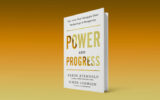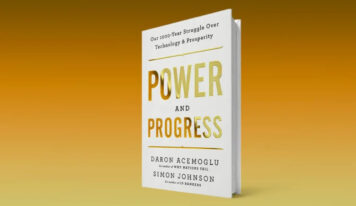Central ideas:
1 – There needs to be an investment in growth areas, such as robotics, but also in a social framework that ensures that those who lose their jobs can stay afloat until they find new roles in other sectors.
2 – There is a dark side to genomics: one of the main apprehensions is that, besides helping in the fight against cancer and other diseases, genomics can start a process of creating custom-made babies, with serious risks for ethics.
3 – Bitcoin is born out of a community that does not trust the old order. It seeks to establish a financial system based on mutual trust, underpinned by algorithms and encryption.
4 -Cybersecurity has become such an essential function that all CEOs of Fortune 300 companies must ensure that one of the directors is a cybersecurity expert.
5 – Many believe that, contrary to the concentration in Silicon Valley, big data will serve as a broadly applicable tool that all existing industries can use to benefit their growth.
About the author:

Alec Ross is a leading expert on innovation. For four years he was Senior Advisor for Innovation in the Secretary of State’s Office under Hilary Clinton. He is currently a Distinguished Visiting Fellow at Johns Hopkins University.
Introduction
This book explores the industries that will be the driving force of the next 20 years of change in our economies and societies. Its chapters are structured around the key industries of the future (robotics, advanced life sciences, money coding, cybersecurity, and big data), as well as the geopolitical, cultural, and generational contexts from which they are being born. These industries were selected not only because they are important in their own right, but also because they are equally symbolic of broader global trends and symbiotic to each other.
Throughout the book, we explore competitiveness-what it takes for societies, families, and individuals to thrive. A cultural consensus is emerging among the world’s most innovative countries and companies on how best to strengthen their most critical resource: people. And there is no greater indicator of an innovative culture than the capacity of women. Fully integrating and empowering women, both economically and politically, is the single most important step a country or company can take to strengthen its competitiveness.
Finally, this book takes a forward-looking perspective, exploring the interventions we can operate in our children’s lives to best prepare them to succeed in a world of increasing change and competition. We can draw on the wisdom of the innovators we address in these pages to prepare ourselves and our children for what is to come in the next economy – for the economy that starts now.
Chapter 1 – The Robots Are Coming
Rival Japanese companies Toyota and Honda are making use of their expertise in mechanical engineering to invent the next generation of robots. Toyota has built a nursing assistant named Robina, a model based on Rosie, the robot nanny and housekeeper from the cartoon series The Jetsons – as part of Partner Robot Family, a line of robots intended to care for the world’s growing geriatric population. Robina is a “woman” robot, weighs 60 kilograms, is 1.2 meters tall, and can communicate using words and gestures. She has big eyes, a round hairstyle with bangs, and even a waving metallic skirt.
Astronaut robot on a mission
In response, Honda created the ASIMO (Advanced Step in Innovative Mobility) robot, a fully functional humanoid with the appearance of a 6-foot astronaut who was stranded on Earth. ASIMO is sophisticated enough to interpret human emotions, movements, and conversations. Equipped with cameras that act as eyes, ASIMO can follow voice commands, shake hands, and answer questions by nodding or voicing. It even bows to greet people, demonstrating that it knows the good Japanese rules of politeness.
Japan is already the world leader in robotics, operating 310,000 of the 1.4 million industrial robots worldwide. It is directing its attention to elderly care robots, partly because it has to, and partly because it has the uniqueness of being in an excellent position to push its advanced industrial technology forward and apply it to the long assembly line that is human life. But can robots care for humans?
China entering the circuit
Some countries have already begun to establish themselves as leading robotics societies. About 70 percent of total robot sales occur in Japan, China, the United States, South Korea, and Germany – known as the “big five” of robotics. Japan, the United States, and Germany dominate the landscape of high-value industrial and medical robots, while South Korea and China are major producers of less expensive, consumer-oriented robots. While Japan records the highest value in robot sales, China represents the fastest-growing market, seeing its sales increase by 25 percent every year since 2005.
Robots and the jobs issue
Investment is needed in growth areas such as robotics, but also in a social framework that ensures those who lose their jobs can stay afloat long enough to turn to industries or jobs that offer new possibilities. Many countries, particularly in Northern Europe, are strengthening the social safety net so that displaced workers maintain hope of re-emerging in a new area. This means taking some of the billions in wealth that will be generated in robotics and reinvesting it in training and skill development for taxi drivers and waiters snatched from their space.
Chapter 2 – The future of the human-machine
Genomic research has been advancing at a rapid pace, even since Gregor Mendel, a Czech monk who discovered the basis of heredity in the mid-19th century. But the big discovery that put genomics on a collision course with medicine occurred in 1995 when the genome of a living organism – Haemophilus influenza, a bacterium that causes serious infections, usually in children – was sequenced for the first time.
Cancer sequencing
Initially, Bert Vogelstein and Luis Diaz made respectable progress in their efforts, but to move to a stage where their work would address many people who needed it, not just operate in the lab for academic purposes, they found that they needed to appeal to private market forces. So in 2009, Diaz and some colleagues at Johns Hopkins launched Personal Genome Diagnostics, PGDx, in which Vogelstein serves as “founding scientific advisor.” PGDx now offers cancer sequencing similar to that applied to Lukas Wartman and also has a research section.
Diaz is candid: “We’re going to have a very good understanding of the pathways activated by cancer, and we hope to eventually have modified drugs that can melt cancer away. That’s truly the goal… And it’s going to take us about twenty to thirty years, if not less.”
Genomics: creating tailor-made babies?
There is a dark side to genomics, recognized even by the scientists most involved in this field. One of the main apprehensions, and something that worries Luis Diaz personally, is that as it gets more sophisticated, genomics will start a process of creating tailor-made babies. “The [genomic] sequencing will inform people about the risks they carry. And those risk profiles will tell them, well, you have a predisposition to heart disease,” Diaz says. “They’ll tell them you’re going to be 5’6″ tall. You’re going to be probably about 180 pounds. You’re going to be one of the best track runners in your class. You’re going to play basketball. You’re going to have a talent for math.”
Mobile telecommunications for life
One of the most interesting ways to use mobile telecommunications to address health problems in the world and development originates from a company called Medic Mobile. I had the opportunity to meet Josh Nesbit, aged 37 and CEO of Medic Mobile, when we were at a company in the middle of a jungle in Colombia, in the last stronghold of the Farc guerrillas. Josh was the mobile communications expert we had brought in to participate in a State Department program in collaboration with the Colombian military and was training local stakeholders on how to use mobile devices to map landmines in the area and reduce loss of life and limb.
Chapter 3 – Encoding money, markets, and trust
With Square, customers could pay (and merchants could sell) using cell phones or tablets. The first iteration involved a small square device that you could insert into your phone to process a credit card payment – you simply swiped the card in a Square reader. The newer iterations of Square don’t even have a slot to insert the card into the device with the shape that gives it its name. All you have to do is hold up your phone to have it read by a device in the case; no need to open your wallet. Many brand-name companies, eager to reduce customer wait times, have adopted this technology. Walk into any Starbucks and see how successive coffee drinkers use Square to get in, out, and refill caffeine faster.
Alibaba facing Paypal
Although eBay and PayPal represent the original American manifestations of this trend, what’s to come will be much more global. One of the first will be Alibaba, headquartered in Hangzhou, China, which currently has over 26,000 employees worldwide and operates in 48 countries across Asia, Africa, Europe, the Americas, and the Middle East. Its Alipay system performs 2.85 million transactions per minute, thus assuming a larger scale than PayPal or Square.
Africa and digital technology
The M-Pesa program in Kenya is a finished example of these new technologies showing us the growing power of money and encrypted markets. Pesa means “money” in Swahili, and the “M” stands for mobile. In communities where bank accounts are rare, with M-Pesa customers can send and receive payments via their cell phones. In Kenya, M-Pesa has been hugely successful. By 2012, there had been 19 million M-Pesa accounts created in a country of 43 million people, and about 25 percent of Kenya’s GDP went through this network.
Could a currency break this traditional link to the nation-state? Could digital technology go so far as to replace banks or governments as arbiters of trust and create a new protocol for doing business around the world?
Bitcoin: Digital Currency
Bitcoin, a new transnational currency launched during the financial crisis in 2008-2009, offers a case study for the future of currency as the codification of money intensifies. Bitcoin is a “digital currency” – a currency that is stored in code and transacted online. It is also a “cryptocurrency,” a term often used interchangeably with “digital currency,” but meaning that the currency uses cryptographic methods in an attempt to make it secure.
Bitcoin became the world’s first cryptocurrency to achieve widespread use. Although there are dozens of cryptocurrencies, it is currently the largest and most influential. At first glance, bitcoin is quite similar to PayPal in that it provides a way to pay for goods online, without the need for physical interaction. Bitcoin has developed a new community around an online currency, trying to bypass established institutions.
Reliance on algorithms and encryption
Bitcoin represented a different effort to regain trust in the financial system. In the old model, the installed institutions functioned as an agent of trust, protecting the parties involved from fraud. Bitcoin is born out of a community that does not trust the old order. They seek to establish a financial system based on mutual trust, underpinned by algorithms and encryption.
Chapter 4 – The warmongering of the code
The Shamoon [cyberattack] was designed to erase the memory of Saudi Aramco’s computer system. Usually, when a file [archive] is deleted from a computer, it is possible to recover it. To permanently erase the contents of the hard drives, Shamoon wrote new useless data over the original data, which prevented the recovery of any of the affected files. Instead, when a person tried to open an affected file, they would see only an icon of a burning American flag. As an additional measure, Shamoon also overwrote Saudi Aramco’s master boot record, thus preventing computers from rebooting.
Business leaders around the world took due note of this event. If the world’s largest company could suffer a cyberattack while operating in a secure environment, it could happen anywhere and to anyone.
Boards with a cyber specialist
Cybersecurity has become such an essential function that all CEOs of Fortune 300 companies must now ensure that one of the directors is a cyber specialist. Just over ten years ago, it became virtually mandatory for all boards of directors to include an audit specialist. In the space of just five years, any board of directors that does not include an element specializing in cybersecurity will be distrusted for its corporate governance capabilities.
Types of cyberattack
There are currently three types of cyberattacks: attacks on the confidentiality, availability, and integrity of a network. Attacks that compromise confidentiality aim to steal or disclose protected information, such as credit card or social security numbers, from a particular system in an unlawful or unauthorized manner. Retailer Target was the victim of a confidentiality attack during the Christmas period of 2013. Hackers accessed Target’s payment systems and managed to steal credit and debit card numbers of more than 40 million customers.
The second type of cyberattack affects network availability – these are attacks commonly known as denial-of-service (DoS) or distributed denial-of-service (DDoS) attacks. Denial-of-service attacks aim to bring down a network by flooding it with a massive amount of requests that render the site inoperable.
Finally, cyber attacks can also affect the integrity of a network. These attacks are more physical. They alter or destroy computer code, and their purpose is usually to cause damage to real-world hardware, infrastructure, or systems… The Shamoon attack was an example of an integrity attack.
Chapter 5 – Data: Raw Material of the Information Age
Digitization has multiplied the possibilities for data collection in an impressive way. Ninety percent of the digital data worldwide has been generated in the last two years. Every year, the amount of digital data grows at a rate of 50 percent. Every minute of the day, 204 million emails are sent, 2.4 million pieces of content are posted on Facebook, 72 hours of video are posted on YouTube, and 216,000 new photos are posted on Instagram. Industrial companies are incorporating sensors into their products to better manage their supply chains and logistics.
Quantity and decisiveness
The value of big data depends in part on the amount of data created, but just as important or more important is our new ability to make smarter and more efficient decisions. Big data is further aided by new developments in data visualization, which allow humans to see and understand patterns that might not otherwise be discernible in a spreadsheet full of numbers.
The story of big data’s impact on the real world up to this point consists largely of logistics and persuasion. It has been great for supply chains, elections, and advertising because these are generally domains with many small, repeatable, and quantifiable actions – hence the “recommendation engines” used by Amazon and Netflix.
Translation, a product of big data
Today’s machine translation is far faster and more effective than our old dictionary method, but it still lacks rigor, functionality, and productivity. Fundamentally, it is little more than a data and processing problem. Professional translators argue that local dialects, inflections, and nuances are too complex for computers to ever sufficiently handle. But they are wrong. Today’s translation tools have been developed by processing more than a billion translations a day for more than 200 million people.
Agriculture: More production, less pollution
Precision farming offers an alternative solution. Instead of blanketing a field with a fixed amount of fertilizer, pesticide, and herbicide, new data will allow us to significantly reduce the number of chemicals we put on farm fields, which in turn will reduce the amount that ends up being thrown by local sensors to determine the exact amount of water and fertilizer to use, precision farming holds promise for growing more food with less pollution, all with the help of big data.
Big data: limitations
As great as the capabilities of big data are, there are still some things it doesn’t do well and for which we don’t see much chance of achieving considerable improvements shortly. I don’t see developments in big data that can change old platitudes like the fact that machines do good things that are hard for people (like, for example, working 24 hours straight or solving a complex math problem quickly) and that people do good things that are hard for machines (like, for example, creativity and understanding social and cultural contexts).
Chapter 6 – Geography of Coming Markets
For more than 20 years, the vast majority of the world’s best computer scientists have been based in Silicon Valley. They may have been born anywhere in the world, but they came to Silicon Valley to study (Stanford or Berkeley), work (creating a self-promoting cycle that concentrates talent), and invest (Silicon Valley’s offering is by far the one that provides the best access to start-up capital in the entire world). And they were integrated into a culture and community that gave the computer engineer the highest level of social status. Silicon Valley became not just any old industrial center, but a kind of beacon – a place that promised not only opportunities but also a sense of belonging – and that continues to attract waves and waves of ambitious entrepreneurs.
Silicon Valley: unique center?
An interesting question arises as to how distributed the industries of the future will be. When a twenty-something guy like Zac Townsend decides to start a company and determines what to do, it has to be in California, a self-perpetuating cycle is created. More broadly, Zac’s decision to locate his new data-driven finance company in Silicon Valley reflects a controversial debate about how expertise in the big data industry will develop and what effect this will have on the overall global economy.
Two answers
And investors are betting big on two very different answers. Will big data serve to centralize business, drawing more sectors into Silicon Valley’s gravitational field? Or will it allow more companies to innovate, wherever they are based, actually creating more opportunities, in more places around the world, than was previously possible?
On one side of the debate stands Charlie Songhurst, who sees Silicon Valley as a sprawling global empire.
Big data as a broad tool
There is a growing public, however, that does not share Charlie Songhurst’s view. They believe that big data, rather than absorbing and supplanting other industries, will serve as a broad tool that all existing industries can use to drive their growth. The idea is that data will become usable in an increasingly broad way and that it will be scalable enough to the point that there will not be a similar specialization as other hard-to-reach industries in the future, such as genomics and robotics.
Collaboration of women
Treating women well is not only the right thing to do: it makes perfect economic sense. Women make up half of a country’s active – or potentially active – population. For a country to be prosperous and competitive, it must have access to the best-educated pool of workers. If a country cuts its potential working population in half, it is automatically putting itself out of the arena. Countries that seek to eliminate the gender gap are competitive; they are the nations of the future, that educate boys and girls and ensure that all their citizens are skilled and ready for the global economy.
Review: Rogério H. Jönck

FACTSHEET:
Original Title: The Industries of the Future
Author: Alec Ross
![[Experience Club] US [Experience Club] US](https://experienceclubus.com/wp-content/uploads/2021/03/laksdh.png)










![[Experience Club] US [Experience Club] US](https://experienceclubus.com/wp-content/uploads/2021/03/logos_EXP_US-3.png)







